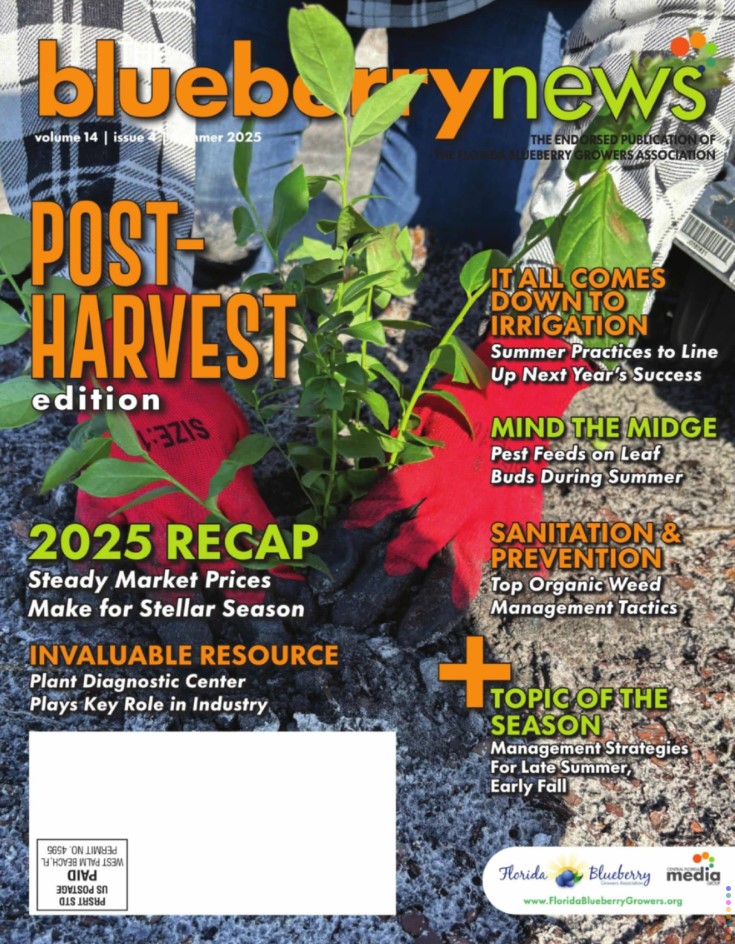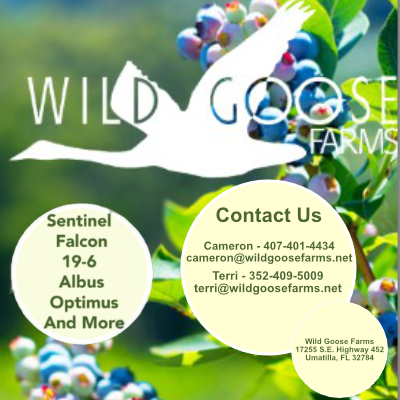Fall and Early Winter Suggested Blueberry Management Items
Remember to take a look at the UF/IFAS Blueberry Growers Guide phone app (now available in English and Spanish) for field scouting tools, as well as information on monthly management suggestions and all of the UF southern highbush blueberry cultivars.
iOS:
https://apps.apple.com/us/app/uf-blueberry-growers-guide/id1535258711
Android:
https://play.google.com/store/apps/details?id=co.austn.ss.blueberry
Credit:
Doug Phillips, UF Blueberry Extension Coordinator
The table below lists suggested blueberry management items for October through January. Suggested management items for the entire calendar year are available in an EDIS publication, Calendar for Southern Highbush Blueberry Management in Florida (https://edis.ifas.ufl.edu/publication/HS1363). Specific disease, insect, and weed controls are listed in the 2022 Florida Blueberry IPM Guide (https://edis.ifas.ufl.edu/publication/HS380), as well as in subject-specific publications referenced below. Also, a list of all UF EDIS blueberry publications can be found at www.blueberrybreeding.com/blog, along with a summary description and link to each.
October
|
Disease |
Monitor and manage leaf diseases, particularly in evergreen systems. See UF EDIS Publication PP348, Florida Blueberry Leaf Disease Guide (https://edis.ifas.ufl.edu/publication/PP348). |
|
Insect Pests |
Spray applicable insecticides or miticides to control blueberry bud mite if present or observed in prior season, southern red mites, and fall webworm. See UF EDIS Publication ENY-1006, Mite Pests of Southern Highbush Blueberry in Florida (https://edis.ifas.ufl.edu/publication/IN1284). |
|
Weeds |
Apply post-emergence herbicide if weeds are at densities that hinder bush growth. See UF EDIS Publication HS90, Weed Management in Blueberry (http://edis.ifas.ufl.edu/pdffiles/WG/WG01600.pdf). |
November
|
Disease |
Monitor and manage leaf diseases, particularly in evergreen systems. See UF EDIS Publication PP348, Florida Blueberry Leaf Disease Guide (https://edis.ifas.ufl.edu/publication/PP348). |
|
Insect Pests |
Begin monitoring for blueberry gall midge using bucket traps (3-5 per acre) or sticky panel traps (1-3 per acre), and spray suggested insecticides when adults are observed. If traps are not used, spray suggested insecticides before floral bud break, with a second spray approximately ten days after the first application, following label directions. See UF EDIS Publication ENY-997 Blueberry Gall Midge on Southern Highbush Blueberry in Florida (https://edis.ifas.ufl.edu/publication/IN1239). Continue monitoring for southern red mites and flat mites, and spray miticides and insecticides with efficacy on mites. See UF EDIS Publication ENY-1006, Mite Pests of Southern Highbush Blueberry in Florida (https://edis.ifas.ufl.edu/publication/IN1284). |
|
Weeds |
Apply post-emergence herbicide if weeds are at densities that hinder bush growth. See UF EDIS Publication HS90, Weed Management in Blueberry (http://edis.ifas.ufl.edu/pdffiles/WG/WG01600.pdf). |
December – January
|
Disease |
Once bloom occurs, monitor for Botrytis flower blight during cool wet periods. If present, spray suggested fungicides in rotation. Applications of fungicides prior to a forecasted need for overhead irrigation as freeze protection can help reduce Botrytis severity on plants damaged by low-temperature injury. See UF EDIS Publication PP198, Botrytis Blossom Blight of Southern Highbush Blueberry (https://edis.ifas.ufl.edu/publication/PP119). Anthracnose (ripe rot) infections can begin as early as bloom; consider preventative fungicide applications and use the Blueberry Advisory System for notifications of increased disease development risk (http://cloud.agroclimate.org/tools/bas/dashboard/disease). January - Apply Ridomil to help prevent Phytophthora root rot. See HS1156, 2022 Florida Blueberry Integrated Pest Management Guide (https://edis.ifas.ufl.edu/publication/HS380). |
|
Insect Pests |
Continue to monitor for blueberry gall midge and spray suggested insecticides when adults are observed. If traps are not used, spray before floral and vegetative bud break, with a second spray approximately 7-10 days after the first application, following label directions. See UF EDIS Publication ENY-997, Blueberry Gall Midge on Southern Highbush Blueberry in Florida (https://edis.ifas.ufl.edu/publication/IN1239). Also scout for scales, southern red mites and flat mites, flower thrips, and blueberry bud mites, and if observed use applicable control measures. See UF EDIS Publications ENY-1006, Mite Pests of Southern Highbush Blueberry in Florida (https://edis.ifas.ufl.edu/in1284) and HS1156, 2022 Florida Blueberry Integrated Pest Management Guide (https://edis.ifas.ufl.edu/publication/HS380) for detailed suggestions. |
|
Weeds |
Apply post-emergence herbicide if weeds are at densities that hinder bush growth. See UF EDIS Publication HS90, Weed Management in Blueberry (https://edis.ifas.ufl.edu/publication/WG016). |
|
Hydrogen Cyanamide |
Consider applying hydrogen cyanamide (marketed as Dormex, and BudPro) in deciduous production systems, in particular those with weak or delayed leaf canopy development and heavy fruit loads. However, at higher concentrations, it can cause floral bud injury and reductions in yield, especially in some cultivars that are more sensitive to hydrogen cyanamide, including ‘Jewel’, ‘Primadonna’, and ‘Colossus’. Growers should do test applications by cultivar on small sections to determine safe concentrations. In addition, application should be made before 20% of the floral buds are at or past stage 3 (separation of bud scales) and after sufficient chilling has occurred to minimize floral bud damage. See further discussion in UF EDIS publication HS976, Reproductive Growth and Development of Blueberry (https://edis.ifas.ufl.edu/publication/HS220). |
|
Freeze Protection |
Monitor forecasted and actual temperatures and utilize freeze protection strategies as needed. See UF EDIS publication HS968, Protecting Blueberries from Freezes in Florida (https://edis.ifas.ufl.edu/publication/HS216). |
|
Pruning |
Dormant pruning can be performed to maintain appropriate plant structure and size. Removal of approximately 25% of old canes should be done annually beginning when a plant is five to six years old, to promote the growth of new canes. Low branches, weak growth, and damaged wood can also be removed at this time. See UF EDIS publication HS1359, Pruning Southern Highbush Blueberry in Florida (https://edis.ifas.ufl.edu/publication/HS1359). |
|
Managed Bees |
Have honey bees (and bumble bees if applicable) delivered; should ideally be placed in the field after 10% bloom but before 20% bloom. On large farms, hives should be distributed throughout the farm to the extent it still allows access to bee providers. Confirm the health of colonies upon delivery; at least 8 frames per hive should have adults, and at least 6 frames should have brood in the cells, with good activity into and out of the hives and on the bushes. Consider adding additional honey bee or bumble bee hives if there is a heavy, concentrated bloom across the farm, nearby competing crops or wild plants blooming at the same time, or ongoing poor weather conditions (cold, windy, or overcast). See additional details in EDIS Publication ENY-172, Pollination Best Practices in Southern Highbush Blueberry in Florida (https://edis.ifas.ufl.edu/publication/IN1237). |





